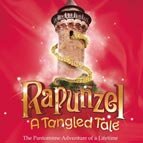Pantos and Christmas shows

Here's our guide to special shows that appear in London theatres around the Christmas period.
If you're familiar with what pantomime is all about, then you may want to skip on to check our current list of upcoming shows.
Traditional festive fun
Pantomimes - or pantos for short - are traditional British family shows.
Though pantos generally appear around Christmas (from about the end of November to the beginning of February) some appear at other times of the year, sometimes in school holidays like Easter or during the summer.
Pantos are largely aimed at family audiences - and it's not unusual to have large family groups, including children and their parents as well as grandparents, aunts, uncles, cousins and friends, all turning-out to watch pantos together.
And you'll often find school parties and other large groups fetching up to join in the fun.
Pantos are often the first time that many children visit the theatre and, since the shows are playing at Christmas time when the excitement level among little people is already reaching a crescendo, the panto atmos buzzes with electric anticipation.
Comedy, magic, sparkle, audience participation, stunning lighting, big musical numbers, singalongs and a good dollop of sheer silliness are all in the essential mix of ingredients that you'll find in pantos.
If you're visiting London from overseas and you've never experienced a panto, it's a must to join British families letting their hair down and enjoying what may often seem to newbies as bizarre - but you'll usually be rewarded with a fun-filled time.
If you want to know more about the history of pantomime, check this Wikipedia page.
And there's a short video from the BBC which explains the origins of pantomime and provides some shots of panto dames at work.
The stories
Even though pantos normally play at Christmas time, the stories are not actually about Christmas at all but are based on traditional fairy tales such as those from Hans Christian Anderson or the collections made by the brothers Grimm.
Adult attendees will know most of the traditional panto storylines, but it may be by visiting pantos that children learn the tales or at least learn some new ones.
Here are some of the most famous panto titles:
Aladdin
Babes in the Wood
Beauty and the Beast
Bluebeard
Cinderella
Dick Whittington and His Cat
Goldilocks and the Three Bears
Hansel and Gretel
Jack and the Beanstalk
Little Red Riding Hood
Mother Goose
Peter Pan
Puss in Boots
Robin Hood
Robinson Crusoe
Sinbad
Sleeping Beauty
Snow White and the Seven Dwarfs
St. George and the Dragon
The Little Mermaid
The Wizard of Oz
Thumbelina
Though theatres can buy-in stock panto scripts, most prefer to have a new script written for their annual panto and may even use the same writer (and, possibly the same cast) for their productions year after year.
Even with a brand new script, the traditional elements of the fairy story will be largely kept in tact, though plenty of modern jokes or references may well be inserted to provide some topicality.
Some writers specialise in panto scripts, such is their love of and fascination with the genre.
So which are the most popular pantos?
A scan through our archives of over 10,000 shows which have played in London over the past few years, it's Cinderella which garners the top spot as most frequently produced panto.
Cinders is trolled by Aladdin with his magic lamp in second place, closely followed by Jack and the Beanstalk, Dick Whittington, Peter Pan and Snow White and the Seven Dwarfs.
Note that panto titles get amended sometimes depending on current events and the exact nature of the production.
For example, a recent variant of Snow White was entitled 'Snow White in the Seven Months of Lockdown'!
And adult pantos frequently contort a panto's title, to make the focus of the story more blindingly obvious and to emphasise the 'naughtiness' of the show.
Conventions
If you're a regular theatregoer, but have never been to a panto before, you'll need to adjust your idea of what visiting the theatre is all about.
Panto has its own style and conventions that are essential elements that make the genre unique and special.
Here's a brief run-down of the main ones ...
Audience participation - passive watching isn't the order of the day in pantos - you're expected to actively participate in the fun and frivolities.
Singalongs, cheering, shouting out to the cast are all expected from the audience during performances and are a much-loved and important part of the whole experience.
And you or your offspring may even find you're invited on to the stage to take part in the action!
Humour - comedy is central to pantos with plenty of silliness to amuse young children and some risqué jokes to appeal to adults.
Though most panto scripts are carefully written not to go too far with 'adult' humour, there are times when parents may find themselves on the train home having to explain to their offspring what they were laughing about.
Gender-swapping - it's not unusual in modern British theatre to find female actors taking male roles or even vice versa, but in panto it is part of the tradition.
Pantos usually have a 'Dame' - a character (often the mother of the hero) who is played by a man (often a well-known actor) dressed in drag.
Similarly, the 'Principal Boy' is usually played by a woman dressed as a man.
Topicality - recent news often figures in panto scripts which may be updated right up to and even beyond the first performance in order to include jokes about current national and international events.
Animals - many pantos feature an animal - eg a cow, cat, camel, horse or goose - depending on the story.
There's no need to worry about any discomfort for any of our furry or feathered friends, though, because animals in pantos are simply actors in costume which usually adds to the comedy.
Outlandish costumes - pantos provide designers with the chance to unleash the wilder side of their creative skills with costumes that blur the boundaries of reality and fantasy.
Bright and gaudy colours, dresses sporting fruit or household implements and hats that tower over actors are just a few of the bizarre creations which frequently appear.
Magic, sparkle and glitz - pantos are often designed to provide some awe and amazement, so expect plenty of glitz and sparkle as well as some illusions or magic to add to the overall wow factor.
ADULT pantos
Though the majority of pantos are meant for family audiences, some are aimed solely at adults and may contain strong language or themes that might be totally unsuitable for your kids - always check listings for age recommendations before booking.
Some theatres - like the King's Head Theatre in Islington - also schedule separate performances for families and adults where the scripts vary according to the audience.
Where can you find pantos?
As the Christmas season approaches, we can have up to 100 pantos and Christmas shows in our listings, so you'll find plenty on offer right across the capital.
In the West End, you'll usually find a spectacular, star-studded panto at the London Palladium - which has a long history in the genre.
It's also well-worth exploring shows outside the West End, where there are theatres that traditionally offer high-quality pantos ...
Greenwich Theatre
Hackney Empire
Lyric Hammersmith
New Wimbledon Theatre
Queen's Theatre Hornchurch
Richmond Theatre
Rose Theatre Kingston
Theatre Royal Stratford East
The Churchill Theatre
There will also be many other theatres that feature pantos or other Christmas shows in their schedules, so it's worth checking our listings to see what's playing.
Theatres usually change their panto story yearly, so don't expect to find the same show playing at a particular theatre every year.
So, if your kids have a particular favourite they want to see, you may have to travel and it might be worth venturing outside the greater London area to visit a show (pantos play in most towns right across the country).
Other Christmas shows
Apart from pantos, there are many other traditional and special Christmas shows that play during the festive season.
Perhaps the best-known of these is the ever-popular 'A Christmas Carol' (from the novella by Charles Dickens) which focuses on the festive redemption of the miserly Ebenezer Scrooge.
In some years, there may be several versions of A Christmas Carol playing in London.
Another annual favourite for many families is 'The Snowman', a stage adaptation of Raymond Briggs’ much-loved book presented by Birmingham Repertory Theatre at The Peacock.
Here's a taster ...
And another Raymond Briggs' favourite 'Father Christmas' often turns up in the schedules.
Summer 2021 also sees the arrival of Andrew Lloyd Webber's new production 'Cinderella' at the Gillian Lynn Theatre.
Though we've yet to see the show, this is a musical comedy retelling of the fairy story rather than a pantomime.
And Disney's musical 'Frozen' is set to open in August 2021 at the Theatre Royal Drury Lane, which is also likely to appeal to family audiences, especially at Christmas.
Booking for shows
Since pantos are incredibly popular and are often attended by large family groups, our best advice is to book early to avoid disappointment.
You'll find some theatres advertise their Christmas shows almost as soon as one year's offering has finished - and they often have discounted ticket prices if you buy early in the year - so it's worth keeping an eye on listings to grab some bargains.
And booking early may also pay off in terms of ticket availability and seating your group together since you'll be in competition with other families.
To find pantos playing in your neighbourhood, check out our listings below which cover the whole of the greater London area, or find a theatre near you from our directory (our theatre listings include links to shows playing).
Supporting theatre
When you book a panto, you're not just supporting that show but you will also be helping to provide financial backing for theatre right through the year.
Such is the power (and profitability) of panto, that theatres around the country make enough money in their Christmas seasons to help cover costs of other shows they put on during the rest of the year.
Without pantos, many theatres would be unable to survive commercially or at least would find it hard to muster funds to put on a wide range of productions.
In the coronavirus epidemic of 2020 the loss of the panto season had damaging effects on theatre finances which may take theatres some years to recover from.
So do consider visiting your local theatre each year to maintain the wonderful tradition of panto and help the venue survive.
Further reading
If you want to know more about pantomime, try these links ...
University of York - History of pantomime
Victoria and Albert Museum - The Story of Pantomime
Grand Theatre Blackpool - A Complete Guide to Pantomime
Listings for pantos and Christmas shows - 2021
Some London theatres announce their Christmas shows early in the year, so we usually only have a handful of listings for pantos between January to March.
Other theatres may not schedule their Christmas shows until late summer or early Autumn, so it's worth checking back here then to review everything that's coming up.
In the Autumn, we'll often have up to 100 listings for pantos and other special festive shows.
Here's our current list of pantos and Christmas shows (in order of their start dates) ...














_105_2015_07_09.jpg)











